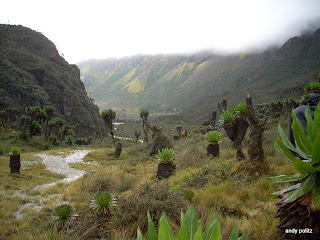
I was awakened last night by, either someone vacuuming outside the wall, or it was RAINING. It came down hard until 11 AM. It came down so hard and steady, I couldn't help but wonder where all the water came from? How does so much get up in the air? And it all starts up as vapor? Come on, you think I was born yesterday? This was the kind of rain that would get through a bucket turned upside down.
With the Marmot rain gear challenge on the table, how did the Exum Jacket do? I do have to admit there was a glistening of moisture inside the jacket. For moisture to move across the fabric (Gore-tex), there has to be a vapor pressure gradient. Or a difference from the inside to the outside. Pressure can not really be considered without including the temperature. With my body temperature near the air temperature and then with very high humidity in the air, there is just not enough temperature and pressure differential to drive moisture through the membrane. Change the humidity or temperature outside to a greater spread from inside the jacket and vapor will move.
However, vapor passage is not the real selling point of raingear. Quality raingear, in my mind, can be most easily determined by the hood. Certainly fit and movement within is pretty critical. Pockets and their location have to be included. Fabric weights, 'hang' and durability are a tough topic when you have to carry the thing (and pack it in an already overfull backpack). Durability and weight is the fine line to walk. In every one of these criteria, Marmot has dinged the bell at the State Fair- you know where you have the big rubber sledge hammer. With the rubber head, the only way to get enough travel out of the travelling dinger-thing is to absolutely hit the hammer-target-thing dead on- and confidently.
Like a Clipper Ship (the fastest multi-masted sailing cargo ships), the Exum jacket had to have come into existence from many, many evolutions.
Marmot has followed the carvers maxim- you start with a big block of marble, and you take away everythig that isn't the sculpture. There is nothing in the Exum jacket that is not a very very fine jacket.
In hard rain, I really felt like I was a kid again, at a drive-in movie. I was sitting inside the car, eating popcorn, while the movie went on outside.
I can't even guess how many shell jackets I have worn over the years... a few dozen, to be sure. There was only one that stands out of the mist, but it delaminated and the company had discontinued the model.
The Marmot Exum Shell is a great jacket. And it has a fresh style to it, as well.
Every cliff had a waterfall pouring down it. With the heavy volume we had overnight and in the morning, every existing waterfall was bounding with water. The trail coming in from above camp was ankle deep. A little splashy creek beside camp, was too deep to cross! Mind you, these trails are, on the outside, sixteen inches wide. We had to retreat from the creek and cross only one rivulet at a time.
It has become clear to me that a good pair of high rubber boots are essential, not just nice. I spent more time in the Muckboots than anything.
Rather than walk in the heaviest rain, Vittorio kept holding us back, finally until eleven o'clock. By then, the rain was easing.
Up to the Elena Hut, the high camp for Mt. Margherita, is a short, but sweet walk. We gained a couple thousand feet of elevation quickly, but, yet again, it was another spectacular trek. There was not a single, ho hum day on the Ruwenzori Circuit. Once we make our altitude by cresting a pass, we wander up rock slabs, just staying off scrambling terrain. Certainly, the Duke of Abruzzi would have been on glacier here. Even though recent ice retreat is very apparent, the rock left behind is cool terrain. You do need to be very careful. There are many places with small house sized rocks laying on slabs. Someday they are going to go. In places, it is a Khumbu Icefall of rock. Move quickly through the bowling alley underneath the 'vacation cabins.'
As I suspect is typical here, we saw nothing upon arrival in a fine mist. The hut here is a smallish A-frame deal, with two 6-person apartments. The guides/ cooks share a second structure next to it. Off beyond it looks to be a porters bunk room.
By the time we had gotten into dry socks, clothes for the climb tomorrow and downed a few hot drinks, the veil was pulled back enough to let us see a few of the enticing features of the show we were here for. We were surrounded by steep rock walls and retreating glaciers. Direct ascents of the two little rock peaks would be 6 to 8 pitches of real rock climbing. With the smaller glacier, the route has shifted up a slabby rock ramp to access the glacier.
Behind us, the broad rock wall of Mt Baker presented itself in its full glory. There ought to be a climb or two on it. We'll be walking by it after we have a go at Margherita.
For the rest of the evening, we just relaxed prior to our summit attempt on the third highest peak in Africa. There are higher and even harder climbing, but nothing in Africa holds a candle to the experience of climbing in the Ruwenzori. No way.









No comments:
Post a Comment